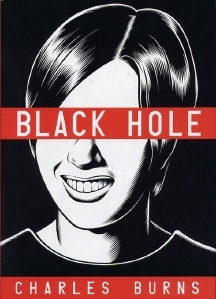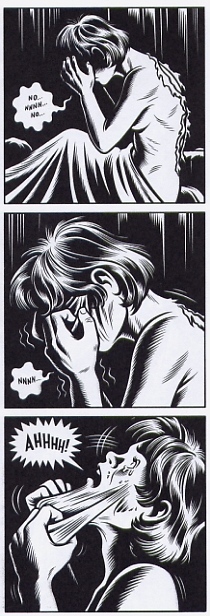Black Hole
Pantheon / Random House
US First Edition Hardcover
ISBN 0-375-42380-X
Publication Date: 10-18-2005
368 Pages; $24.95
Date Reviewed: 01-31-06
Reviewed by: Rick Kleffel © 2006

REFERENCES
COLUMNS
|
|
|
Black HolePantheon / Random HouseUS First Edition HardcoverISBN 0-375-42380-XPublication Date: 10-18-2005368 Pages; $24.95Date Reviewed: 01-31-06Reviewed by: Rick Kleffel © 2006 |
 |
|
REFERENCES |
COLUMNS |
Generally, horror is not an end in itself, but rather a means to an end. It's a scalpel, a convenient instrument for laying open the emotions and fears of the characters in a narrative. It's a great way to externalize humanity, to gut us and animate those entrails, to make them dance and sing of our sickness. But horror need not simply be a servant. It can be a destination, an endpoint, the terminus of a thought-train. Sometime, we don’t need to be informed. Sometimes, we just need to experience fear, and sometimes, fear is all there is within us to experience.
 |
|
| A page from Burn's horror novel. |
'Black Hole' by Charles Burns is an experience of horror, through and through. There is no moment of this graphic novel that is not shot through with disgust, with disease and unease. It is an experience of life in the negative, an evocation of the worst things that await us both within and without. 'Black Hole' is also an object of utter beauty, a vision so perfectly formed, a story so gripping, real and unreal, that it lures us in and holds us in spite of its complete and abject success as a horror novel. Burns' brilliant combination of art and storytelling exerts a real power and will remain unpleasantly fixed in your mind long after you've closed the covers.
The setting is the suburbs of Seattle and the time is the mid-1970's. Keith is an ordinary teenager, lucky enough to be paired with the school fox, Chris in Biology 101. While dissecting a frog, Keith experiences a disturbing, surreal vision and passes out. Later, smoking pot in the woods with his friends he sees a deformed man in the distance -- and then finds what looks like a shed human skin. Things will never be the same, for Keith, Chris or anyone in the vicinity of 'Black Hole'.
Though it took the author ten years to complete the novel, if you sit down to read it now, you'll finish it in a couple of days. Burns is a master of plotting and presentation. The pages are unnumbered, but 'Black Hole' is divided into convenient chapters that are titled and expertly paced. Though the book seems dauntingly thick, it is a joy to read. The cast is rather large, but Burns' combination of illustration and narrative keeps everyone crystal clear, in-focus and individual. Most of the characters are straightforward suburban teenagers, caught in the grip of adolescent change and a disease that transforms some of them into monstrous horrors. Others are subtly, even sexually affected. At center stage, Keith and Chris make as appealing a pair as possible, given the pitch-black vision of Burns. They're nice normal kids, and if you weren't one of them, you probably knew (or know) kids like them. As they undergo the changes induced both by their own hormones and by the disease, readers will feel a kinship, a connection.
These aren't the only people to inhabit Burns' world. The rest of the cast is equally affecting though they’re not all as likeable as Chris and Keith. A pathetic cast of exiles, diseased and living in the woods outside of town, is the most genuinely creepy group of kids you're likely to met on the printed page. There is a mystery at the heart of this novel. Once the disease is defined, once it has settled, the murders begin. As the mysteries unfold, as the lives crumble and disintegrate, as the horror subsumes them, you'll cry and cringe in terror. Burns makes these people very, very real.
Burns' plot is amazingly tight for a story that covers such a long period of time and a large cast. There's a nicely understated quality at work here. Nothing seems forced or overly plotted; rather, this is real life, as it is lived, within the distressed skin of an American adolescent. They're changelings, in flux, battered from within by forces they cannot comprehend but that seem to be world-changing, all-important. And it's true -- their world is being changed from within, as are they. Burns' very small bit of the fantastic, this disease that disfigures his characters, is the perfect method of exteriorizing the internal angst of the teenager.
But 'Black Hole' is not simply one of those horror stories that literally opens up its characters and says, "Oh, gross." I've refrained thus far from mentioning the part that Burns' art plays in this work, but of course it is critical. Burns is an inhumanly precise illustrator. Working in a palette of blacker-than-black and white, every single image is there to induce unease, to express distress. Yes, there's an objective point-of-view the reader is forced to assume. The perfection of Burns' art is a constant reminder of how achingly beautiful it is in spite of the repellant nature of what Burns shows us. The beauty, such as it is, erupts on occasion, as Burns' characters experience startlingly surreal visions. There are some magnificent vistas in here, Lovecraftian netherworlds that suggest an invasion from without, through the within. But whether he's showing you a flower or a gutted frog, Burns is going to give you the shivers. He's aided by incredibly good production and printing. Pantheon deserves credit for giving Burns a great physical version of this very physical book.
Ultimately, 'Black Hole' is a masterpiece of body horror. Those surreal visions are all that a mind mired in this ugly lump of deforming, reforming flash can achieve. Burns is using his visual skills to explore what it means to be alive, and for Burns, in 'Black Hole', to be alive is to be dying. Life is a means of birthing death and thus a source of constant horror. 'Black Hole' is a source of constant horror as well, one of the few works of the genre to effectively explore as an end what is usually a means to an end.